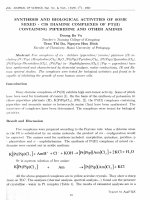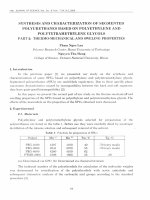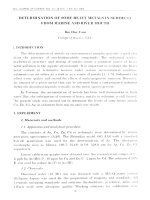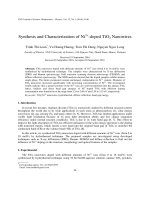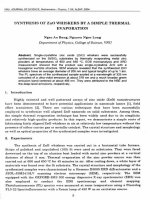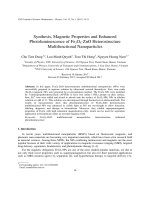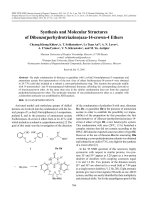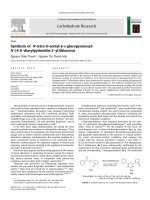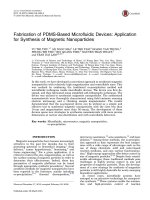DSpace at VNU: Synthesis of PtRu C-CNTs electrocatalysts for DMFCs with treated-CNTs and composition regulation
Bạn đang xem bản rút gọn của tài liệu. Xem và tải ngay bản đầy đủ của tài liệu tại đây (1.45 MB, 7 trang )
Home
Search
Collections
Journals
About
Contact us
My IOPscience
Synthesis of PtRu/C-CNTs electrocatalysts for DMFCs with treated-CNTs and composition
regulation
This content has been downloaded from IOPscience. Please scroll down to see the full text.
2014 Adv. Nat. Sci: Nanosci. Nanotechnol. 5 035015
( />View the table of contents for this issue, or go to the journal homepage for more
Download details:
IP Address: 198.91.37.2
This content was downloaded on 21/02/2015 at 03:18
Please note that terms and conditions apply.
|
Vietnam Academy of Science and Technology
Advances in Natural Sciences: Nanoscience and Nanotechnology
Adv. Nat. Sci.: Nanosci. Nanotechnol. 5 (2014) 035015 (6pp)
doi:10.1088/2043-6262/5/3/035015
Synthesis of PtRu/C-CNTs electrocatalysts
for DMFCs with treated-CNTs and
composition regulation
Long Quan Dang1,2,3, Manh Tuan Nguyen2, Viet Long Nguyen3,5,6,
Minh Thi Cao4, Van Thang Le7, Le Hoai Phuong Nguyen8,
Ngoc Phuong Nguyen2, Thanh Hoang Nguyen2 and Thi Nga Do2
1
College of Natural Sciences, Can Tho University, Ninh Kieu District, Can Tho City, Vietnam
Ho Chi Minh City Institute of Physics, 01 Mac Dinh Chi, District 1, Ho Chi Minh City, Vietnam
3
Laboratory for Nanotechnology, Vietnam National University in Ho Chi Minh City, Community 6, Linh
Trung Ward, Thu Duc District, Ho Chi Minh City, Vietnam
4
Ho Chi Minh City University of Technology, 144/24 Dien Bien Phu, Ward 25, Binh Thanh District, Ho
Chi Minh City, Vietnam
5
Posts and Telecommunications Institute of Technology, km 10 Nguyen Trai, Hanoi, Vietnam
6
Shanghai Institute of Ceramics, Chinese Academy of Science, 1295, Dingxi Road, Shanghai 200050,
People’s Republic of China
7
Ho Chi Minh City University of Technology, District 10, Ho Chi Minh City, Vietnam
8
Tay Do University, Cai Rang District, Can Tho City, Vietnam
2
E-mail: , and
Received 14 March 2014
Accepted for publication 18 August 2014
Published 5 September 2014
Abstract
In the present work, PtRu/C-CNTs catalyst samples were studied for potential applications in
direct methanol fuel cells (DMFCs). Carbon nanotubes (CNTs) were treated by H2SO4 98% and
HNO3 65% at different temperatures and with different stirring periods. As a result, the PtRu/CCNTs catalyst was successfully synthesized by using H2PtCl6 and RuCl3 precursors with the
efficient reduction of NaBH4 agent in ethylene glycol (e.g.). In addition, we controlled the ratios
of treated-CNTs on carbon vulcan XC-72 treated-CNTs substrate (C-CNTs) with the different
values: 50 wt%, 25 wt%, and 12.5 wt%, respectively. The PtRu/C-CNTs electrocatalyst samples
were investigated by experimental methods including x-ray diffraction (XRD), transmission
electron microscopy (TEM), and cyclic voltammetry (CV). Importantly, the CV results show the
best treated-CNTs and the most suitable ratio of CNTs composition on C-CNTs substrate to be
controlled in order to produce various efficient PtRu/C-CNTs catalysts with high catalytic
activity for DMFCs.
Keywords: carbon nanotubes, direct methanol fuel cells, PtRu/C-CNTs electrocatalyst
MSC numbers: 5.06
1. Introduction
operation principle [3]:
Anode: CH 3OH + H 2 O → CO2 + 6H + + 6e− ,
3
Cathode: O2 + 6H + + 6e− → 3H 2 O,
2
3
Overallreaction: CH 3OH + O2 → CO2 + 2H 2 O.
2
Fuel cells (FCs) are recognized as promising energy power
sources for the future [1]. Among various FCs, direct
methanol fuel cells (DMFCs) are known as a low operation
temperature cell, using methanol fuel and the membrane–electrode assembly (MEA) technology [2]. The Pt based catalysts are used in the electrodes of DMFCs, following
2043-6262/14/035015+06$33.00
1
© 2014 Vietnam Academy of Science & Technology
Adv. Nat. Sci.: Nanosci. Nanotechnol. 5 (2014) 035015
L Q Dang et al
However, the Pt catalyst is easily poisoned by carbon
monoxide (CO) which was produced from hydrogen oxidation reaction (HOR). This problem is solved by using Pt–Ru
based catalysts. The Ru metal composition will reduce CO in
Pt–CO bondings as follows [2]:
Ru + H 2 O → Ru − OH + H + + e− ,
Ru − OH + Pt − CO → Pt + Ru + CO2 + H + + e− .
Conventionally, highly conductive carbon blacks, such as
vulcan XC-72, are used as supports for Pt electrocatalysts.
After the discovery of carbon nanotubes (CNTs) [4], Pt/CNTs
based catalysts were investigated by many authors [1, 5–11].
Before the use of CNTs, they must be treated in strong acids,
such as HNO3 or a mixture of HNO3 and H2SO4, at a temperature and a period value to remove impurities and generate
amounts of functional groups, e.g., –OH, –COOH, –C = O on
the CNTs surfaces [1]. However, there are significant differences about temperatures and periods treated between
authors. For example, Li et al refluxed CNTs in 70% HNO3 at
120 °C for 4 h and then treated them in a 4.0 N H2SO4–HNO3
mixture for 4 h [5]; Zhao et al purified MWNTs by refluxing
them with 60% HNO3 at 90 °C for 2 h and then the surface
oxidation of the MWNTs was carried out by refluxing
MWNTs in 4 M H2SO4 + 4 M HNO3 at 90 °C for 5 h [7], the
group of Lee treated CNTs for 36 h at 110 °C in a mixed
solution of HNO3 and H2SO4 [11], and so forth [1, 8–10].
Besides, the effect of the ratio of CNTs composition on CCNTs substrate on quality of PtRu/C-CNTs electrocatalyst
has not been studied so far.
In this work we have prepared PtRu/C-CNTs catalyst
samples using many types of CNTs that were treated at different temperatures and with different stirring periods.
Besides, we have also prepared PtRu/C-CNTs electrocatalyst
samples using different ratios of treated-CNTs. Our purpose is
to find out the best treated-CNTs sample and the best ratio of
treated-CNTs for PtRu/C-CNTs electrocatalysts.
Figure 1. The image of CNTs, supplied by producer.
Table 1. Data sheet of CNTs, supplied by producer.
Properties
Value
C-purify
Outer diameter
Inner diameter
Length
>95 wt%
<12 nm
∼2 nm
>1 μm
Table 2. CNTs treatment samples.
Sample name
PtRu/C-CNTs
PtRu/C-CNTs
PtRu/C-CNTs
PtRu/C-CNTs
PtRu/C-CNTs
PtRu/C-CNTs
Temperature
01
02
03
05
06
07
Room
50 °C
50 °C
100 °C
100 °C
Room
Time (hours)
5
5
10
5
10
10
2. Experimental
2.1. CNTs treatment
The CNTs material in our work was manufactured by Ho Chi
Minh City University of Technology, Vietnam. Parameter and
image of CNTs are shown in figure 1 and table 1.
In our experiments on treated-CNTs (called experiment
1), CNTs samples were dissolved in H2SO4 98%–HNO3 65%
mixture with the volume ratio 1:1 under ultrasonic treatment
for 15 min They were refluxed at temperatures and with
stirring periods, as presented in table 2.
In the experiment on the ratio of CNTs composition with
C-CNTs substrate (called experiment 2), CNTs sample was
dissolved in H2SO4 98% + HNO3 65% with the volume ratio
1:1 under ultrasonic treatment for 15 min This mixture was
then stirred at room temperature for 5 h. After 5 h, activated
CNTs were washed by centrifugal filter method to remove
acid impurities. Finally, it was dried at 100 °C under vacuum
condition for several hours.
Figure 2. XRD pattern of PtRu/C-CNTs catalyst sample.
2
Adv. Nat. Sci.: Nanosci. Nanotechnol. 5 (2014) 035015
L Q Dang et al
Figure 3. TEM images of PtRu/C-CNTs catalyst samples. (a): PtRu/C-CNTs 03 sample; (b): PtRu/C-CNTs 06 sample; (c): PtRu/C-CNTs 23
sample; and (d): PtRu/C-CNTs 24 sample (see also tables 2 and 3).
Table 3. Ratios of treated-CNTs in different PtRu/C-CNTs samples
Sample name
Carbon vulcan mass (mg)
CNTs mass (mg)
20
30
35
20
10
5
PtRu/C-CNTs 23
PtRu/C-CNTs 24
PtRu/C-CNTs 25
Ratio of CNTs
50%
25%
12.5%
Table 4. The result of CV investigation of PtRu/C-CNTs
2.2. Preparation of PtRu/C-CNTs electrocatalysts
electrocatalyst samples.
2.2.1. Experiment 1 (on treated-CNTs).
Firstly, we have used
4 mg activated CNTs, 36 mg carbon vulcan XC-72 (10%
CNTs), 10 ml acid H2SO4 98%, and 40 ml ethylene glycol.
Their mixture was treated by ultrasonic method for 15 min
Then the mixture was stirred at 150 °C for 30 min. After that,
the precursor of PtRu (H2PtCl6.6H2O and RuCl3.xH2O
solution) was added. Here, atomic ratio of Pt:Ru was equal
to 1:1. The ratio of PtRu composition with 20 wt% on PtRu/
C-CNTs was controlled in all samples. Next, 0.4 g NaBH4
and 20 ml DI water solution was sprinkled into the mixture.
The pH was adjusted to about 12 by using NaOH. The
mixture was stirred at room temperature for 6 h. It was dried
at 100 °C under vacuum condition for several hours. Finally,
we gained the PtRu/C-CNTs electrocatalyst sample.
Sample name
PtRu/C-CNTs
PtRu/C-CNTs
PtRu/C-CNTs
PtRu/C-CNTs
PtRu/C-CNTs
PtRu/C-CNTs
01
02
03
05
06
07
If (A cm−2)
Ir (A cm−2)
If/Ir
0.03 145
0.02 034
0.02 086
0.01 554
0.06 150
0.05 323
0.01 048
0.00 553
0.00 150
0.00 155
0.02 557
0.02 804
3.0
3.7
13.9
10.0
2.4
1.9
below (table 3). Next, these samples were treated by
ultrasonic method in 10 ml acid H2SO4 98% and 40 ml
ethylene glycol solution for 15 min, then they were stirred at
150 °C for 30 min After that, the precursor of PtRu,
H2PtCl6.6H2O and RuCl3.xH2O solution (atomic ratio Pt:
Ru = 1:1, the ratio of PtRu composition with 20 wt% on
PtRu/C-CNTs was controlled in all samples) was added.
Solution of 0.4 g NaBH4 and 20 ml DI water was sprinkled
2.2.2. Experiment 2 (on the ratio of CNTs composition with CCNTs substrate). Firstly, mixtures of activated CNTs and
carbon vulcan XC-72 were produced following the ratios
3
Adv. Nat. Sci.: Nanosci. Nanotechnol. 5 (2014) 035015
L Q Dang et al
Figure 4. CV of PtRu/C-CNTs electrocatalyst samples. (a) PtRu/C-CNTs 01 sample; (b) PtRu/C-CNTs 07 sample; (c) PtRu/C-CNTs 02
sample; (d) PtRu/C-CNTs 03 sample; (e) PtRu/C-CNTs 05 sample and f) PtRu/C-CNTs 06 sample.
into mixtures. The pH was adjusted to about 12 by using
NaOH. Mixtures were stirred for 6 h at room temperature.
Finally, they were dried at 100 °C under vacuum condition
for several hours. We gained PtRu/C-CNTs electrocatalyst
samples.
All of PtRu/C-CNTs electrocatalyst samples were
investigated by x-ray diffraction (XRD), transmission electron
microscopy (TEM) and cyclic voltammetry (CV).
2 mg PtRu/C-CNTs electrocatalyst on 1 cm2 Toray carbon
paper and it was a working electrode in CV system. CV
investigation was performed on PARSTAT 2273 system
using 0.5 M H2SO4 + 1.0 M CH3OH solution, with a sweep
rate of 50 mV s−1.
2.3. Electrochemical investigation on methanol electrooxidation
3.1. XRD and TEM characterizations
3. Results and discussion
XRD spectrum of a typical PtRu/C-CNTs catalyst sample was
surveyed in figure 2. It has four diffraction peaks at the angle
2θ of 39.7°, 46.3°, 67.9° and 81.6° corresponding to the
surface (111), (200), (220) and (311), respectively. These
Electrochemical investigation on methanol electro-oxidation
of PtRu/C-CNTs samples was carried out by cyclic voltammetry. Each PtRu/C-CNTs sample was prepared by coating
4
Adv. Nat. Sci.: Nanosci. Nanotechnol. 5 (2014) 035015
L Q Dang et al
Figure 5. Comparison between CV couples at the same temperature. a) PtRu/C-CNTs 01 sample versus PtRu/C-CNTs 07 sample; b) PtRu/CCNTs 02 sample versus PtRu/C-CNTs 03 sample and c) PtRu/C-CNTs 05 sample versus PtRu/C-CNTs 06 sample.
Figure 6. CV of PtRu/C-CNTs electrocatalyst samples. a) PtRu/C-CNTs-23 sample; b) PtRu/C-CNTs 24 sample; c) PtRu/C-CNTs 25
sample.
peaks are characteristic of the fcc structure of platinum.
According to Sherrer’s formula, the average size of PtRu
nanoparticles is about 5.2 nm.
Figure 3 presents a typical sample of PtRu/C-CNTs
nanoparticles. It clearly shows that PtRu nanoparticles were
made up on CNTs and carbon vulcan with a high
homogeneousness.
3.2. Cyclic voltammetry investigation
3.2.1. Experiment 1 (on treated-CNTs). CV investigation of
PtRu/C-CNTs electrocatalyst samples is presented in figure 4.
According to previous results [12], the oxidation of methanol
is observed in the forward scan at point A, and an oxidation
peak in the reverse scan at point B, which is attributed to the
5
Adv. Nat. Sci.: Nanosci. Nanotechnol. 5 (2014) 035015
L Q Dang et al
highest value (77.09 mA cm−2), while the If of PtRu/C-CNTs
25 sample (ratio of CNTs 12.5 wt%) is the lowest
(15.78 mA cm−2).
From table 5, the lowest and highest value of If/Ir ratio
are 2.25 and 27.21 for the sample PtRu/C-CNTs 24 and PtRu/
C-CNTs 25, respectively. This means the PtRu/C-CNTs 25
sample (ratio of CNTs 12.5 wt.%) has the best CO tolerance.
Despite the PtRu/C-CNTs 25 sample having the highest
value of If/Ir ratio, it methanol oxidation ability has the lowest
value. Hence, we make the choice between the PtRu/C-CNTs
23 sample and the PtRu/C-CNTs 24 sample. In this case, the
PtRu/C-CNTs 24 sample has methanol oxidation ability
superior to that of PtRu/C-CNTs 23 sample but their If/Ir ratio
is similar, 2.94 and 2.25, respectively (figure 7 and table 5).
Figure 7. Comparison between PtRu/C-CNTs_23 sample and PtRu/
C-CNTs_24 sample.
4. Conclusion
Table 5. The result of CV investigation of PtRu/C-CNTs
PtRu/C-CNTs electrocatalyst was successfully synthesized by
using of H2PtCl6 and RuCl3 precursors with the reduction of
NaBH4 agent in ethylene glycol with high homogeneousness.
In the first experiment, PtRu/C-CNTs electrocatalyst samples
using CNTs were treated by H2SO4 98% and HNO3 65% at
different temperatures and with different stirring periods. We
also synthesized PtRu/C-CNTs electrocatalyst samples using
different ratios of treated-CNTs in the second experiment. The
results showed that the methanol oxidation ability of samples
under stirring for 10 h was always higher than samples under
stirring for 5 h. In addition, the sample stirred at 100 °C for
10 h has the highest methanol oxidation ability. The CV results
also show that the methanol oxidation ability of PtRu/C-CNTs
24 sample (ratio of CNTs 25 wt%) is far superior compared
with other samples. Therefore, it may be the best choice sample
of PtRu/C-CNTs electrocatalyst for DMFCs.
electrocatalyst samples.
Sample name
PtRu/C-CNTs 23
PtRu/C-CNTs 24
PtRu/C-CNTs 25
−2
−2
If (A cm )
Ir (A cm )
If/Ir
0.02 808
0.07 709
0.01 578
0.00 956
0.03 429
0.00 058
2.94
2.25
27.21
removal of the incompletely oxidized carbonaceous species
formed in the forward scan. These carbonaceous species are
mostly in the form of linearly bonded Pt − C ≡ O [13]. The
result of CV investigation also shows a wide difference
between samples, presented in table 4.
Table 4 provides the value of peak current density of the
methanol oxidation peak in the forward scan (If) and the
reverse scan (Ir) of PtRu/C-CNTs electrocatalyst samples. It
clearly shows that the If of PtRu/C-CNTs 06 sample (strirred
for 10 h at 100 °C) receives the highest value, 61.5 mA cm−2.
It also proves that If value of samples under strirring for 10 h
is higher than that of samples under strirring for 5 h at the
same temperature, this is confirmed by figure 5.
The ratio of the forward peak current density to the
reverse peak current density (If/Ir) can be used to describe the
issue of catalyst tolerance to CO accumulation [12, 13]. From
table 4, the lowest and highest values of If/Ir ratio are 1.9 and
13.9 for the sample PtRu/C-CNTs 07 and PtRu/C-CNTs 03,
respectively. It means that PtRu/C-CNTs 03 sample (strirred
for 10 h at 50 °C) has the best CO tolerance.
References
[1] Jeng K, Chien C, Hsu N, Yen S, Chiou S, Lin S and Huang W
2006 J. Power Sources 160 97
[2] Long N V, Thi C M, Yong Y, Nogami M and Ohtaki M 2013
J. Nanosci. Nanotechnol. 13 4799
[3] Hoogers G 2003 Fuel Cell Technology Handbook (Boca
Raton, FL: CRC Press)
[4] Iijima S 1991 Nature 354 56
[5] Li W, Liang C, Qiu J, Zhou W, Han H, Wei Z, Sun G and
Xin Q 2002 Carbon 40 791
[6] Wang C, Waje M, Wang X, Tang J M, Haddon R C and Yan Y
2004 Nano Lett. 4 345
[7] Prabhuram J, Zhao T S, Liang Z X and Chen R 2007
Electrochim. Acta 52 2649
[8] Wu G and Xu B Q 2007 J. Power Sources 174 148
[9] Jha N, Reddy A L M, Shaijumon M M, Rajalakshmi N and
Ramaprabhu S 2008 Int. J. Hydrogen Energy 33 427
[10] Xu J, Hua K, Sun G, Wang C, Xiangyu L and Wang Y 2006
Electrochem. Commun. 8 982
[11] Lee T K, Jung J H, Kim J B and Hur S H 2012 Int. J. Hydrogen
Energy 37 17992
[12] Naidoo Q, Naidoo S, Petrik L, Nechaev A and Ndungu P 2012
Int. J. Hydrogen Energy 37 9459
[13] Liu Z and Hong L 2007 Electrochem. 37 505
3.2.2. Experiment 2 (on the ratio of CNTs composition with CCNTs substrate). CV investigation of PtRu/C-CNTs
electrocatalyst samples in this experiment is presented in
figure 6 and the result of CV investigation shows a wide
difference between samples presented in table 5.
Similarly to experiment 1, table 5 provides the value of
peak current density of the methanol oxidation peak in the
forward scan (If) and the reverse scan (Ir) of PtRu/C-CNTs
electrocatalyst samples. The table clearly shows that the If of
PtRu/C-CNTs 24 sample (ratio of CNTs 25 wt%) receives the
6

